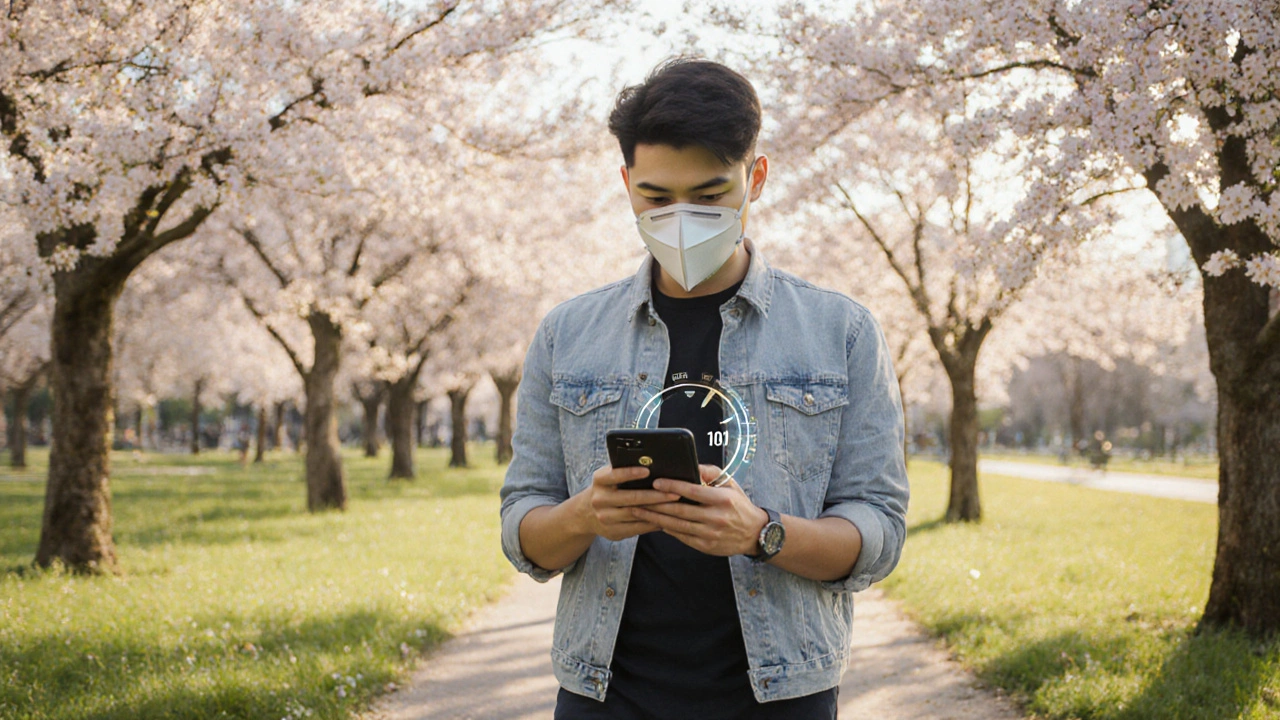
Allergy is an immune system response that reacts to otherwise harmless substances, causing symptoms like sneezing, itching, or breathing difficulties.
How Allergies Shape Everyday Life
When a sneeze interrupts a presentation or a rash makes sleep impossible, the ripple effect reaches work, school, relationships, and mental health. A 2023 epidemiology report estimated that more than 30% of adults in NewZealand report at least one moderate‑to‑severe allergy, and the associated absenteeism costs the economy roughly NZ$2billion each year. Beyond the obvious discomfort, chronic exposure to allergens can trigger inflammation that worsens mood, reduces exercise tolerance, and even lowers self‑esteem.
Common Types and Their Unique Burdens
Allergic rhinitis is a nasal inflammation caused mainly by pollen, dust‑mite or pet dander exposure. People with this condition often experience a runny nose, watery eyes, and congestion that impair concentration. In schools, it is the leading cause of missed classes during spring.
Food allergy involves an immune reaction to proteins in foods such as peanuts, shellfish, or dairy. A single bite can provoke hives, gastrointestinal distress, or anaphylaxis- a life‑threatening emergency that demands an epinephrine autoinjector on hand.
Asthma is a chronic airway disease that frequently co‑exists with other allergic conditions. Triggers like mold spores or cold air can cause wheezing, limiting physical activity and increasing sick‑day leave.
Atopic dermatitis (eczema) presents as itchy, inflamed skin that worsens with humidity changes or certain fabrics. Nighttime itching often disrupts sleep, leading to daytime fatigue and reduced productivity.
Measuring the Real‑World Impact
Quality of Life (QoL) scales translate symptom burden into numerical scores. The Rhinoconjunctivitis Quality of Life Questionnaire (RQLQ) scores range from 0 (no impact) to 6 (severe impact). A recent NZ cohort recorded an average RQLQ of 3.2 for pollen allergy sufferers during peak season, correlating with a 12% drop in self‑reported work efficiency.
Allergy management strategies That Actually Work
Effective control blends three pillars: avoidance, medication, and immune modulation.
- Avoidance: Identifying and limiting exposure to trigger allergens. Simple steps- using HEPA filters, washing bedding in hot water, or checking pollen forecasts- cut symptom severity by up to 40%.
- Medication: Fast‑acting relief (antihistamines) and long‑term inflammation control (nasal corticosteroids).
- Immune modulation: Allergen immunotherapy (shots or sublingual tablets) reshapes the immune response, offering lasting remission for many.
Below is a quick comparison of the three most common treatment routes.
| Option | Onset of Relief | Typical Duration | Common Side Effects |
|---|---|---|---|
| Antihistamines | 15‑30minutes | 6‑12hours (single dose) | Dry mouth, mild drowsiness |
| Nasal Corticosteroids | 2‑3days | Daily, long‑term | Nasal irritation, rare nosebleeds |
| Allergen Immunotherapy | 6‑12months (clinical improvement) | 3‑5years (maintenance) | Local swelling, occasional systemic reaction |

Lifestyle Tweaks That Make a Difference
Beyond prescription choices, everyday habits can tip the balance toward comfort.
- Home Air Quality: Deploy a HEPA filter in the bedroom, keep humidity below 50% to deter dust mites, and vacuum with a sealed‑bag system.
- Dietary Support: Omega‑3‑rich fish, probiotic‑laden yogurt, and a low‑histamine diet have shown modest reductions in nasal inflammation (average RQLQ drop of 0.5 points in trial data).
- Sleep Hygiene: Use hypoallergenic pillow covers and maintain a consistent bedtime; better sleep restores cortisol rhythms that regulate immune activity.
- Stress Management: Mindfulness or moderate exercise curtails the release of stress‑mediated histamine, decreasing flare‑ups.
Building a Personal Allergy Action Plan
Confidence comes from preparation. A robust plan includes:
- Allergy Testing: Skin prick or specific IgE blood tests pinpoint culprits. Recent guidelines suggest testing before initiating immunotherapy.
- Emergency Kit: Carry an epinephrine autoinjector (for food or insect venom allergy) and educate anyone close to you on its use.
- Medication Schedule: Set reminders for daily nasal sprays; use a pill organizer for antihistamines during high‑pollen weeks.
- Trigger Log: Record symptoms, locations, and foods for 2‑3weeks. Patterns help refine avoidance tactics.
Related Concepts and Next Steps
Understanding allergies sits within a broader immune‑health context. Topics such as immune system regulation, gut microbiome influence, and genetic predisposition provide deeper insight. For readers ready to dive further, consider exploring:
- How the gut microbiome modulates allergic responses.
- Advances in sublingual immunotherapy (SLIT) for pediatric patients.
- Season‑specific pollen forecasts and mobile alerts.
Each of these areas builds on the foundation laid here, helping you transition from symptom management to long‑term resilience.
Frequently Asked Questions
What is the best first step after being diagnosed with an allergy?
Start a detailed trigger log and discuss targeted avoidance measures with your clinician. Knowing exactly what sets off your symptoms guides the choice of medication or immunotherapy.
Can lifestyle changes really lower my allergy scores?
Yes. Studies show that using HEPA filters, maintaining low indoor humidity, and adding probiotic foods can shave 0.3‑0.5 points off the RQLQ, translating into noticeable relief.
How long does it take for allergy shots to work?
Patients typically notice reduced symptoms after 6‑12months of regular injections, with full benefit emerging after 3‑5years of maintenance.
When should I switch from antihistamines to a nasal steroid?
If daily antihistamines fail to control congestion or eye symptoms after two weeks, adding a nasal corticosteroid is recommended. Combining both often yields the best control.
Is it safe to rely solely on over‑the‑counter meds?
OTC antihistamines are fine for mild, intermittent symptoms, but moderate‑to‑severe cases usually need prescription‑strength steroids or immunotherapy for lasting relief.





Comments (13)
Emily Moody
Allergic flare‑ups are the silent saboteurs of our great American productivity. The cytokine cascade-essentially a hostile biochemical invasion-can cripple even the most stalwart patriot in the boardroom. When pollen drenches the Midwest, the airborne onslaught triggers histamine storms that rival any political turmoil. Deploying HEPA filters and nasal corticosteroids becomes a civic duty, preserving our nation's competitive edge. Remember, a well‑managed immune response is as vital to our freedom as the Constitution itself.
Prateek Kohli
I hear you, and the science does back up those mitigation steps 🙂. While a filter helps, pairing it with a proper trigger log ensures we tackle the problem from both angles. It's all about finding that personal equilibrium without letting the allergy narrative become partisan.
Anastasia Petryankina
Ah, the noble pursuit of quantifying misery-because apparently, our society needed a spreadsheet to validate the inconvenience of a sneeze. The RQLQ, with its dazzling range from zero to six, feels like the academic's version of rating a soufflé's fluffiness. One might argue that a score of 3.2 during pollen season is merely a gentle reminder that nature refuses to bow to our calendar. Yet, the real tragedy lies not in the nasal congestion but in the sheer audacity of a pollen grain to travel cross‑continental distances. Imagine, if you will, a microscopic adventurer equipped with a protein payload, probing the delicate architecture of our nasal epithelium. Our immune system, ever the over‑zealous sentinel, launches histamine missiles that render us helplessly sniffling in the boardroom. The statistical correlation of a 12% dip in work efficiency is, of course, the inevitable consequence of such a microscopic uprising. One could, in a fit of scholarly romance, suggest that the annoyance of a runny nose is the price we pay for intellectual refinement. In the grand hierarchy of human suffering, allergic rhinitis comfortably occupies the middle rung-far above a stubbed toe, yet below existential dread. The proposed avoidance regime-HEPA filters, hot‑water bedding cycles, and pollen forecasts-reads like a liturgical rite for the modern germophobe. What truly dazzles me is the pharmaceutical industry's capacity to package antihistamines as zen‑inducing tablets, despite their notorious side effect of dry mouth. Nasal corticosteroids, with a recommended onset of two to three days, are practically the slow‑cooking broth of allergy therapy. And then there is immunotherapy, the marathon of medical commitment, promising remission after the patient has endured six to twelve months of periodic injections. One must admire the courage of individuals who willingly subject themselves to a regimen that could, in theory, reshape their immune tolerance. In the end, perhaps the greatest lesson is that we have engineered a civilization wherein a harmless pollen grain can dictate our sleep patterns, productivity, and, dare I say, our very sense of self.
Noah Cokelaere
Your poetic homage to the humble pollen is entertaining, but let’s cut to the chase: does anyone actually track the cost of those HEPA filters on a student budget? Also, how many injections does it take before you stop feeling like a human pin cushion? I’m curious if the payoff truly justifies the inconvenience.
Ashley Helton
Sure, let’s all buy a set of industrial‑grade air purifiers and become the first nation of sneeze‑free citizens-if only our wallets were as resilient as our immune systems. Honestly, a simple daily nasal spray does half the job while leaving us enough cash for coffee. It’s a win‑win, right?
Bridget Dunning
While your proposal is laudable, empirical data suggest that routine administration of intranasal corticosteroids achieves a statistically significant reduction in nasal obstruction scores, with a p‑value <0.05. Moreover, integrating humidity control (<50%) synergistically enhances mucosal barrier integrity, thereby attenuating allergen penetration. Consequently, a multimodal protocol encompassing pharmacotherapy, environmental engineering, and patient education aligns with best‑practice guidelines promulgated by the Australasian Society of Clinical Immunology.
Shweta Dandekar
Allergy sufferers must adopt vigilance!!!
Patrick Price
Honestly i dont think all this hype about mebecing allergy free is worth it. Who needs a filter when you can just sneeze it out?? Just kidding but seriously, i think most ppl just ignore the real probelm.
Travis Evans
Yo, fam! If you’re battling those sneaky pollen monsters, start small-grab a cheap pocket‑size HEPA filter for your desk and keep that nasal spray on lock. Consistency beats perfection, so set a daily reminder and watch those symptoms dip like a rock‑star’s mic drop!
Jessica Hakizimana
Life’s little annoyances, like a sudden itch, can be seen as teachers that nudge us toward greater self‑awareness. When an allergen triggers a flare‑up, it’s the body’s way of reminding us that balance is a moving target, not a static state. Embracing mindfulness practices, such as focused breathing during a sneeze, can transform discomfort into a moment of presence. Moreover, cultivating gratitude for the moments when your immune system stays quiet amplifies overall well‑being.
peter derks
Exactly! I love the idea of turning a sneeze into a mindfulness cue. I’ve started a habit of pausing for a breath after each bout, and it’s surprisingly grounding. Keep sharing these hacks!
Sarah DeMaranville
People love to glorify OTC antihistamines as miracle cures but they’re just temporary band‑aid solutions.
Edward Leger
The reliance on fleeting pharmacologic fixes reflects a deeper cultural trend of seeking instant gratification over sustained resilience. A contemplative approach-examining lifestyle variables and embracing gradual adaptation-offers a more enduring path to health.